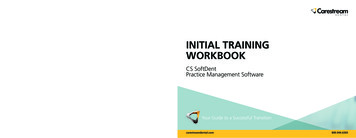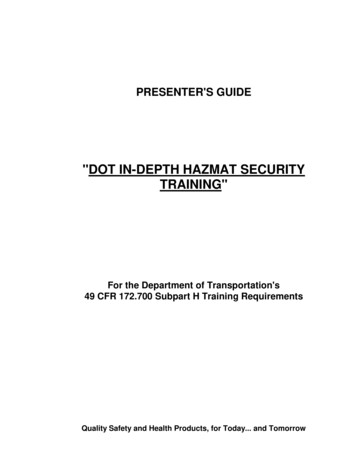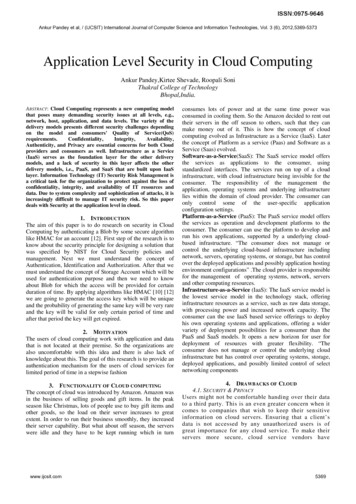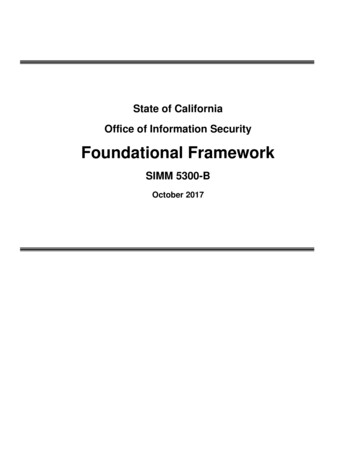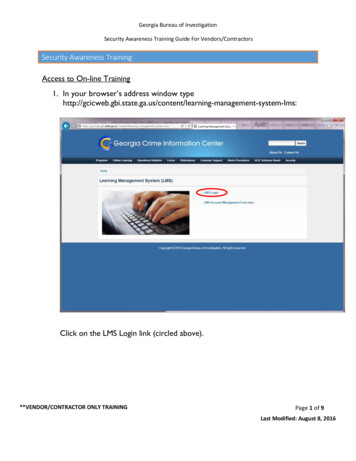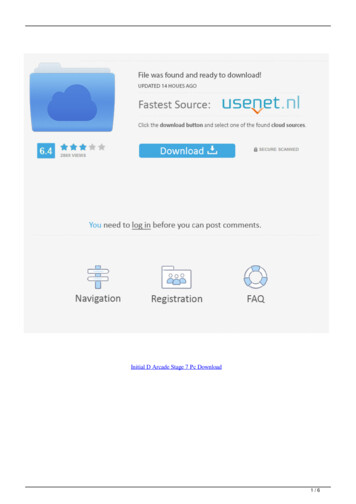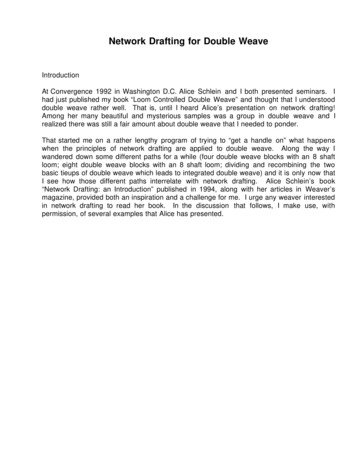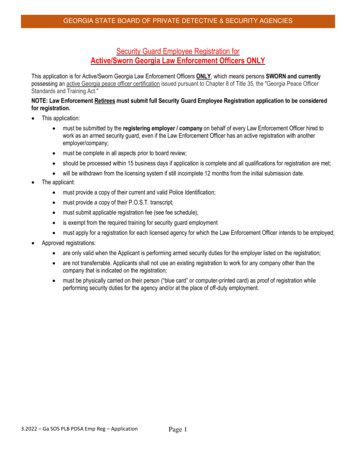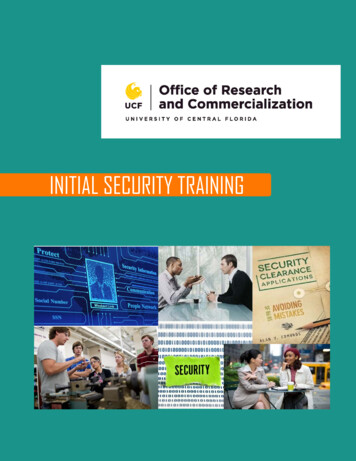
Transcription
INITIAL SECURITY TRAINING
TABLE OF CONTENTSAcknowledgment2Introduction3Reporting Requirements5Procedures and Duties7Safeguarding assification Overview10Insider g the Non‐Disclosure Agreement13Glossary14Initial Security Training 1
ACKNOWLEDGMENTYou have been granted a Department of Defense (DoD) security clearance andconsequently the U.S. government has provided authority for you to access certainclassified information.As a recently cleared individual for the University of Central Florida, there are basicsecurity concepts you will need to learn. This initial security training will provide youwith foundational knowledge, expectations, and requirements you will need tounderstand prior to beginning work on any classified information, data, material, orrestricted or closed areas.Thank you,Dela WilliamsFacility Security OfficerUniversity of Central FloridaOffice of Research and CommercializationInitial Security Training 2
INTRODUCTIONINDIVIDUAL SECURITY RESPONSIBILITIESThe U.S. government has established detailed requirements which are outlined in the NationalIndustrial Security Program Operating Manual (NISPOM) to ensure the protection of classifiedinformation. Part of your role as a cleared University of Central Florida employee is to protectour nation from a variety of threats. Our National Security is constantly under attack byadversaries both foreign and domestic; by protecting classified information, you are fulfilling acritical role in protecting our nation.This initial security training will provide security procedures that are critical for clearedemployees to understand and comply with government security regulations. Although eachcleared facility adheres to set government security standards, implementation procedures mayvary from site to site.PENALTIESPenalties for unauthorized disclosure of classifiedinformation, which can be assessed against bothcleared employees and the organization, include: Criminal, Civil, and Other Measures Fines of up to 10,000 Imprisonment of up to 10 yearsFor defense contractors such as UCF,Defense Security Service (DSS) is theprimary DoD security agency assignedto oversee the protection of classifiedinformation.Initial Security Training 3
INTRODUCTION (CONT)NISPOM 3‐107. Initial Security Briefings. Prior to being granted access to classified information, an employeeshall receive an initial security briefing that includes the following:a. A threat awareness security briefing, including insider threat awareness in accordance with paragraph 3‐103bof this Manual.b. A counterintelligence awareness briefing.c. An overview of the security classification system.d. Employee reporting obligations and requirements, including insider threat.e. Initial and annual refresher cybersecurity awareness training for all authorized IS users (see chapter 8,paragraph 8‐101c, of this Manual).f. Security procedures and duties applicable to the employee's job.NISPOM Reference:3‐103b. Insider Threat Training. All cleared employees must be provided insider threat awareness trainingbefore being granted access to classified information, and annually thereafter. Training will address current andpotential threats in the work and personal environment and will include at a minimum:(1) The importance of detecting potential insider threats by cleared employees and reporting suspected activityto the insider threat program designee.(2) Methodologies of adversaries to recruit trusted insiders and collect classified information, in particularwithin ISs.(3) Indicators of insider threat behavior, and procedures to report such behavior.(4) Counterintelligence and security reporting requirements, as applicable.8‐101c. ISs Security Program. In addition to the training requirements outlined in paragraphs 3‐107 and 3‐108of chapter 3 of this Manual, all IS authorized users will receive training on the security risks associated withtheir user activities and responsibilities under the NISP. The contractor will determine the appropriate contentof the security training taking into consideration, assigned roles and responsibilities, specific securityrequirements, and the ISs to which personnel are authorized access.3‐108. Refresher Training. The contractor shall provide all cleared employees with some form of securityeducation and training at least annually. Refresher training shall reinforce the information provided during theinitial security briefing and shall keep cleared employees informed of appropriate changes in securityregulations. See paragraph 8‐103c of chapter 8 of this Manual for the requirement for IS security refreshertraining. Training methods may include group briefings, interactive videos, dissemination of instructionalmaterials, or other media and methods. Contractors shall maintain records about the programs offered andemployee participation in them. This requirement may be satisfied by use of distribution lists,facility/department‐wide newsletters, or other means acceptable to the FSO.8‐103c. Contractor Responsibilities. All IS users will:(1) Comply with the ISs security program requirements as part of their responsibilities for the protection of ISsand classified information.(2) Be accountable for their actions on an IS.(3) Not share any authentication mechanisms (including passwords) issued for the control of their access to anIS.(4) Protect authentication mechanisms at the highest classification level and most restrictive classificationcategory of information to which the mechanisms permit access.(5) Be subject to monitoring of their activity on any classified network and the results of such monitoring couldbe used against them in a criminal, security, or administrative proceeding.Initial Security Training 4
REPORTING REQUIREMENTSCleared employees have a number of reporting requirements you must adhere to in order to maintain yoursecurity clearance. These reporting requirements are centered on events and activities that could potentiallyimpact your ability to protect classified information.CHANGE IN PERSONAL STATUSADVERSE INFORMATION Name Citizenship including acquiring dual citizenshipand/or foreign passportsYou must also report information that reflectsunfavorably on the integrity or character of yourself oranother cleared individual that may impair the abilityto safeguard classified materials. This information isdefined as adverse information. Residence Marital status Cohabitation in a spouse‐like relationship with aforeign national Job assignment no longer requiring a securityclearanceSUSPICIOUS CONTACT Any contact with an individual that is suspicious innature, whether they are a U.S. or foreign person Someone taking an unusual interest in you andyour job and/or asking probing questions aboutwhat you do and who you work forThese contacts can occur online, through social media,email, via‐phone, written correspondence, or in‐person.Some examples of suspicious contacts include: Request for protected information under theguise of a price quote or purchase request, marketsurvey, or other pretense Attempts to entice cleared employees intosituations that could lead to blackmail or extortion Attempts by foreign customers to gain accessto hardware and information that exceeds thelimitations of the export license on file Attempts to place cleared personnel underobligation through special treatment, favors, gifts,or moneyThese reports should be made to the Facility SecurityOfficer or Designated Security Representative and ifyou are in doubt as to whether something isreportable.Some examples of adverse information include: Known or suspected violation of security rules byyou or another individual Known or suspected compromise of classifiedinformation by you or another individual Any arrest, criminal activity, or civil court actions‐ Traffic fines over 300 (not including courtfees) Treatment for psychological, mental, emotional,and personality disorders and counseling, exceptfamily/marriage, grief and combat‐relatedcounseling (unless the counseling was precipitatedby a violent action or event) Substance abuse Medical marijuana (prior to use) Use of illegal controlled substances (which includesmarijuana under federal law) Unexplained affluence Excessive indebtedness or recurring financialdifficulties (e.g., foreclosure or bankruptcy) Knowledge of an employee not wanting to performon classified work Close or continuous contact with a foreign personor entity Misuse of any company or U.S. governmentinformation systems Behavior causes an individual to be vulnerable tocoercion, exploitation, or duress and/or reflectslack of discretion or judgement (to include behaviorof a sexual nature)Initial Security Training 5
REPORTING REQUIREMENTS (CONT)FOREIGN TRAVELMEDIA CONTACTSForeign travel increases the risk of foreign intelligencetargeting. You can be the target of a foreign intelligenceAny media inquiries about your job or organizationshould be reported: ongoing personal contacts withmedia representatives who cover your organization oryour subject specialty should be cleared with security.or security service at any time and any place; however,the possibility of becoming the target of foreignintelligence activities is greater when you travel overseas.The foreign intelligence services have better access to you,and their actions are not restricted within their owncountry’s borders.You may possess or have access to information that ishighly sought after by foreign entities, including: Friendly information Research, development, testing, and evaluation Program milestones and specifications System capabilitiesForeign entities also target information related to yourorganization’s personnel, security, and operations.A favored tactic for industrial spies is to attend tradeshows and conferences. This environment allows them toask questions, including questions that might seem moresuspect in a different environment. One assessmentestimated that one in fifty people attending such eventswere there specifically to gather intelligence.PRE-PUBLICATION REVIEWAny technical paper, book, magazine article, ornewspaper article that you prepare for publication orfor posting on the Internet, or lecture or speech thatyou prepare to give, must be cleared in advance if itcontains information or knowledge you gained duringyour current or any previous job.LOSS OR COMPROMISE OF INFORMATIONIf you inadvertently or accidentally lose orcompromise classified or other sensitive information,this must be reported.OUTSIDE ACTIVITIESAny planned or actual outside employment orvolunteer activity that could create a real or apparentconflict with your designated job duties.Specific Threats to Travel Destination:U.S. Department of State information:http://travel.state.gov/Crime is one of the biggest threats facing travelers.Crimes against travelers are crimes of opportunity.Follow these steps to protect yourself: Stay alert and exercise good judgment When possible, ensure that your hotel room has apeephole and a deadbolt lock or a chain‐and‐slide bolt If you travel with valuables, put them in the hotel safe Find out what parts of town locals consider risky andavoid them Keep your car doors locked and suitcases out of sight If you see an accident, don't stop; instead, call for helpfrom a safe area Minimize the amount of cash you carry Be wary of street vendors and innocent‐lookingyoungsters as they may be decoys for pick pocketsInitial Security Training 6
PROCEDURES AND DUTIESLEVELS OF CLASSIFIED INFORMATIONThe United States government has three levels ofclassified information. The level of classificationis determined by the degree of negative impactto National Security if improperly disclosed. Theclassification levels are defined as: CONFIDENTIAL ‐ This classification is assignedwhen the unauthorized disclosure of informationor material could reasonably be expected to causedamage to National Security. SECRET ‐ This classification is assigned when theunauthorized disclosure of information or materialcould reasonably be expected to cause seriousdamage to National Security. TOP SECRET ‐ This classification is assigned whenthe unauthorized disclosure of information ormaterial could reasonably be expected to causeexceptionally grave damage to National Security.You may sometimes hear classified informationreferred to as “National Security” information or“collateral” information.Rank, level, or position within thecompany does not equal a clearanceor need‐to‐know.RELEASE OF INFORMATIONPrior to releasing information, the holder must ensurethat the recipient of the information has both: Proper security clearance – Cleared individualsmay access classified information at or below theirclearance level Need‐to‐know – Each individual shall only begranted access to the specific classified informationthat is absolutely required to perform their job.If you have a question about whether someone shouldhave access to classified materials and information,ALWAYS contact your Facility Security Officer orDesignated Security Representative.“Collateral” refers toclassified materials for whichspecial requirements are notformally established.Initial Security Training 7
PROCEDURES AND DUTIES (CONT)HANDLING OF CLASSIFIED INFORMATIONSafeguardingSome general safeguarding guidelines include: Never leave classified material unattended Secure classified material in a government‐approved container or area Properly protect combinations that control accessto classified materials and areasReproduction Understand how your facility secures classifiedmaterials and areas at the end of each day Reproduction of classified material:‐ Should always be kept to a minimum‐ Should be performed only by authorizedpersonnel familiar with the procedure When transmitting classified information outsideof an authorized facility, comply with all specialrequirements Take actions to prevent the loss or unauthorizeddisclosure of classified information; be mindfulwhen holding classified discussions (such ashallways, cubicles, break rooms, etc.)‐ Should be performed only on authorizedequipmentTransmission Be aware of local policies or restrictions regardingcell phones, cameras, MP3 players, tablets, andany other personal electronic device enteringclassified areasAll classified materials coming in and out of afacility by mail, fax, or courier must be sent andreceived by the Facility Security Officer orDesignated Security Representative. Understand the various types of approved areasfor classified operations including but not limitedto closed and restricted areasIf you receive a classified package directly, notifyyour Facility Security Officer or Designated SecurityRepresentative IMMEDIATELY!Retention / Disposition Recognize that classified material comes invarious forms (such as documents, hardwareor assets, electronic media, communications ortransmissions)In case of emergency, follow allpractical security measures forsafeguarding classified materialas the situation allows.YOUR PERSONAL SAFETYCOMES FIRST! Contractors are authorized to retain classifiedmaterial received or generated under a contract fortwo years following completion of the contract,unless other guidance is provided by the GovernmentContracting Authority (GCA). Classified material should only be retained forvalid contract performance purposes anddispositioned when no longer needed. Destruction of classified information must beaccomplished by authorized methods andpersonnel ONLY. Understand the destructionmethods at your facility.Initial Security Training 8
PROCEDURES AND DUTIES (CONT)UNAUTHORIZED RELEASE OFCLASSIFIED INFORMATIONThere are negative impacts associated with theunauthorized release of classified information. Theseimpacts include but are not limited to: Damage to National Security Weakened integrity of classified informationand technical advantage Damage to company reputation and customerrelationships Potential negative impact on award fees Loss of classified contracts and/or exclusionfrom biddingSECURITY INCIDENT REPORTING Loss of personal security clearanceand/or employmentThe improper safeguarding, handling, reproduction,transmission, disposition, or disclosure of classifiedmaterial is a reportable security incident.DATA SPILLSData Spills, also known as data contaminations,are a form of unauthorized release of classifiedinformation. Data spills occur when classifiedinformation is either intentionally or unintentionallyintroduced to an unclassified or unaccreditedinformation system. Improper handling of data is atthe core of most data spills.The best way to prevent a data spill is to focus onwhat you can control: Know where to find and how to use securityclassification guides for your program or project Properly handle and appropriately mark classifiedinformation If you receive or discover classified or potentiallyclassified information on an unclassifiedinformation system, immediately contact yourFacility Security Officer or Designated SecurityRepresentative for guidance. Do not forward,print, save, or delete the suspected information.If you commit or discover a potential security incident,immediately report the circumstances to your FacilitySecurity Officer or Designated Security Representativeand, if possible, ensure the material involved isproperly safeguarded. When reportingan incident, be cognizant not to disclose classifiedinformation over unsecure means.Security personnel will evaluate the circumstances andtake actions as appropriate.By adhering to security procedures, you ensureclassified information is properly protected andcontribute to the nation’s security.By properly protecting information, we meet ourcontractual obligations, enhance customer trust,help ensure University of Central Florida’scontinued ability to compete for new businessopportunities, and maintain our reputation.Initial Security Training 9
CLASSIFICATION OVERVIEWInformation becomes classified by a designated Original Classification Authority after it has been determinedthe information is owned, produced by or for, or controlled by the United States, and that unauthorizeddisclosure could result in damage to National Security.When marking classified material (i.e. documents,media, or electronic files), the following must beincluded: The overall level of classification Title of the materialClassification markings may be identified from thefollowing two places: Security Classification Guides (SCGs) or equivalentguideline authorized for your effort Existing properly marked source materialauthorized for use on your effort Date created Name and address of the originating facility Identity of the classifierClassification markings help facilitate propersafeguarding requirements and assist in the preventionof inadvertent release. Period of time protection is required Any sources used to classify the information Any portions that contain classified informationYou may be required to perform derivativeclassification decisions in the course of your jobresponsibilities; if this is the case, you will receiveadditional training in greater detail.Carrying forward these markings to newly‐generated material is our responsibility as contractors, whomake derivative classification decisions when we include existing classified information into new forms.SECRETSECRET(U) Originally Classified Document(U) Derivatively Classified DocumentAugust 29, 2014August 30, 2014U.S. Navy Program Executive Office123 Washington DriveWashington, DC 20004University of Central FloridaP. O. Box 4430Winter Park, FL 32793Classified By: John Smith, Senior Program ManagerReason: 1.4(a)Derived From: XYZ Security Classification Guide, dated11 Nove 2014, U.S. NavyDowngrade On: 20291105Downgrade To: CONFIDENTIALDeclassify On: 20391105Classified By: Name & Position OR Personal IdentifierDerived From: Originally Classified Document, datedAugust 29, 2014, U.S. NavyDowngrade On: 20291105Downgrade To: CONFIDENTIALDeclassify On: 20391105SECRETSECRETClassification markings and examples inthis guide are for training purposes only.Initial Security Training 10
INSIDER THREATWhat is an INSIDER THREAT?It is a sad reality, but the United States has been betrayed by people holding positions of trust.Arguably, “insiders” have caused more damage than trained, foreign professional intelligence officers working onbehalf of their respective governments.This information is intended to help (you) the contractors within the National Industrial Security Program recognizepossible indications of espionage being committed by persons entrusted to protect this nation’s secrets.Not every suspicious circumstance or behavior represents a spy in our midst, but every situation needs to beexamined to determine whether our nation’s secrets are at risk.DSS defines insider threat as: Acts of commission or omission by an insider who intentionally orunintentionally compromises or potentially compromises DoD’s ability to accomplish its mission. These acts include,but are not limited to, espionage, unauthorized disclosure of information, and any other activity resulting in the lossor degradation of departmental resources or capabilities.How can YOU help?You and your colleagues are the first line of defense against espionage. Help protect our national security byreporting any suspicious behavior that may be related to a potential compromise of classified information. Be awareof the actions of those around you and report suspicious behaviors.INSIDER THREAT CASE STUDYInitial Security Training 11
COUNTERINTELLIGENCECounterintelligence is defined as information gathered and activities conducted to identify, deceive, exploit,disrupt, or protect against espionage or sabotage; conducted for or on behalf of foreign powers, organizations,international terrorist groups or individuals.What does that mean to you?Counterintelligence is identifying intelligence threatsto the University of Central Florida, other defensecontractors, and our government customers, anddeveloping strategies to mitigate those threats.As a recently cleared employee with the Universityof Central Florida, it’s important you understandthese threats.Intelligence threats can come from foreignintelligence services, foreign and/or domestic industrycompetitors, criminal, terrorist, and/or extremeactivist organizations, and trusted insiders, also knownas the insider threat.Intelligence collection can come in a variety ofdifferent forms, including: elicitation, open sourcecollection, electronic surveillance, cyber intrusions,social engineering, exploitation of social media, andformal recruitment.Recruitment occurs when an employee collectsinformation on behalf or at the direction of a foreignintelligence service. Formal recruitment is often theprecursor to insider threat activity.The insider threat is someone who has legitimateaccess to company or classified USG information anduses that access to steal information for theirForeign IntelligenceServicesForeign and/orDomestic IndustryCompetitorsforeign intelligence service, on their behalf. Indicatorsof insider threat activity might include an apparentdisgruntlement with employer or USG, disregardfor security and IT procedures, outward expressionof loyalties towards competitors or foreign nations,unreported foreign travel or foreign contacts, or asudden shift in demeanor.The ultimate goal of a foreign intelligence officer issuccessful recruitment of an employee who can actas an insider on their behalf. As a University ofCentral Florida employee and a member of thecleared community, you are an elevated target forrecruitment and intelligence collection by thosethat seek access to classified information andclassified information systems.You are also in the best position to observe behaviorssuggesting concerns of an insider threat in theworkplace. Employee should contact their FacilitySecurity Officer or Designated SecurityRepresentative immediately if they have concernsthey’ve been involved in a recruitment attempt orother intelligence collection attempts, or if they haveany concerns of potential insider threat activity in theworkplace.Criminal, Terrorist,and/or ExtremeActivist OrganizationsTrusted InsidersInitial Security Training 12
CONCLUSIONThis initial security training provided you with information on: Your reporting requirements The security duties and procedures applicable to your job The Security Classification System Counterintelligence, the insider threat, and defensive security practices to mitigate these threatsRemember that each area/ facility supports unique contracts and may implement requirements in slightlydifferent ways. To be successful in your new role as a cleared University of Central Florida employee, it isimperative that you work closely with your Facility Security Officer or Designated Security Representativeregarding the content reviewed in this initial security training and any additional area/facility specificrequirements.YOUR SECURITY CLEARANCE ELIGIBILITY IS A CONTINUING RESPONSIBILITY!Now that you have received your security clearance, you play an integral part in ensuring the success ofUniversity of Central Florida Security Program and our National Security. The nature of your newresponsibilities relates directly to our customers.Are you able and willing to safeguard classified national information or perform national security sensitiveduties? Your loyalty, character, trustworthiness, and reliability will determine your qualification to hold asecurity clearance eligibility or sensitive position. Your continued diligence in monitoring your behavior andresponsibly dealing with life’s events will help you maintain your eligibility for a security clearance oroccupancy of a national security sensitive position. Should you have any questions, contact your FacilitySecurity Officer or Designated Security Representative.Completing the Non‐Disclosure Agreement (NDA/Standard Form 312)Now that you have completed this training, please schedule an appointment withUCF’s Facility Security Officer or Designated Security Representative to complete therequired Classified Information Non‐Disclosure Agreement also known as the StandardForm (SF) 312.Before being granted access to classified information, you must first sign a Non‐Disclosure Agreement or NDA. The NDA is a legal and binding contract between youand the U.S. Government whereby you agree to protect any and all classified nationalsecurity information to which you will have access.Be advised that the NDA is binding for LIFE! A Life‐Long Commitment!Initial Security Training 13
GLOSSARYCollateral – All National Security information classifiedConfidential, Top Secret or Secret under the provisionsof an executive order for which special communitysystems of compartmentation (e.g., non‐SpecialCompartmented Information (non‐SCI)) are notformally establishedConfidential – A level of classification that is assignedwhen the unauthorized disclosure of informationor material could reasonably be expected to causedamage to National SecurityCourier – An individual who has been briefed andmeets the requirements to transport classifiedmaterialsDerivative classification decisions – The incorporating,paraphrasing, restating, or generating in new forminformation that is already classified, and markingthe newly developed material consistent with theclassification markings that applies to the sourceinformation. Derivative classification includes theclassification of information based on classificationguidance. The duplication or reproduction of existingclassified information is not derivative classification.DoD – Department of DefenseDSS – Defense Security ServiceInformation System (IS) – An assembly of computerhardware, software, and firmware configured for thepurpose of automating the functions of calculating,computing, sequencing, storing, retrieving, displaying,communicating, or otherwise manipulating data,information and textual material.Insider – Cleared contractor personnel with authorizedaccess to any Government or contractor resource,including personnel, facilities, information, equipment,networks, and systems.Insider Threat – The likelihood, risk, or potential thatan insider will use his or her authorized access,wittingly or unwittingly, to do harm to the nationalsecurity of the United States. Insider threats mayinclude harm to contractor or program information, tothe extent that the information impacts the contractoror agency’s obligations to protect classified nationalsecurity information.GCA – Government Contracting Authority, whichprovides guidance to contactorsNeed‐to‐know – must be in place along with a securityclearance to be granted access to specific classifiedinformation required to perform a jobNISPOM – National Industrial Security ProgramOperating ManualSecret – A level of classification that is assigned whenthe unauthorized disclosure of information or materialcould reasonably be expected to cause serious damageto National SecuritySecurity clearance ‐ An administrative authorizationfor access to National Security information up toa stated classification level (Top Secret, Secret,Confidential).NOTE: A security clearance does not, by itself, allowaccess to controlled access programsTop Secret – A level of classification that is assignedwhen the unauthorized disclosure of informationor material could reasonably be expected to causeexceptionally grave damage to National SecurityUSG – United States governmentAn extensive list of security termscan be found at the DefenseSecurity Service website.Initial Security Training 14
(4) Counterintelligence and security reporting requirements, as applicable. 8‐101c. ISs Security Program. In addition to the training requirements outlined in paragraphs 3‐107 and 3‐108 of chapter 3 of this Manual, all IS authorized users will receive training on the security risks associated with
